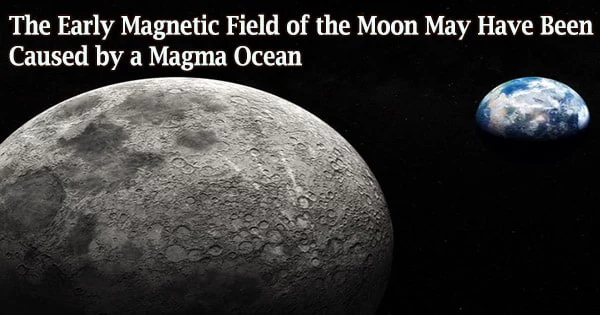The Moon’s magnetic field was about equivalent to that of the Earth’s today four billion years ago. In the history of the Moon’s evolution, it has been unclear how the Moon, which has a smaller core than the Earth, was able to have such a potent magnetic field.
To find out what might have driven this early lunar magnetic field, researchers Aaron Scheinberg of Princeton University, Krista Soderlund of the University of Texas Institute for Geophysics, and Linda Elkins-Tanton of Arizona State University set out. Recent publications in Earth and Planetary Science Letters include their findings as well as a new model for how this might have occurred.
A new model
The majority of the solar wind, whose charged particles would otherwise strip away the ozone layer protecting the Earth from dangerous UV radiation, is diverted away from our planet by the magnetic field of the Earth.
The motions of the Earth’s convecting liquid metal outer core, or dynamo, produce its magnetic field, but the Moon’s core is too small to have produced a magnetic field of that size.
As a result, the research team put out a fresh hypothesis for how the magnetic field could have become comparable to that of Earth. In this case, a thick coating of molten rock that rests on top of the Moon’s little metal core acts as the dynamo’s power source.
According to this hypothesis, the Moon’s mantle melts to create a “basal magma ocean” that is rich in metal and lies on top of the metal core. The dynamo is then driven by convection in this layer, producing a magnetic field.
Our model provides an elegant potential solution. As the Moon cooled, the magma ocean would have solidified, while the core dynamo would have continued to create the later weak field.
Aaron Scheinberg
“The idea of a basal magma ocean dynamo had been proposed for the early Earth’s magnetic field, and we realized that this mechanism may also be important for the Moon,” says co-author Soderlund.
Soderlund continues by saying that it is believed that the lunar mantle’s base still contains a layer that is partially molten.
“A strong magnetic field is easier to achieve at the Moon’s surface if the dynamo operated in the mantle rather than in the core,” she says, “because magnetic field strength decreases rapidly the farther away it is from the dynamo region.”
The team’s simulations of the Moon’s core dynamo repeatedly revealed that the bottom layer of the mantle was melting and overheating. These initially sought to concentrate on melting-free scenarios because they were simpler to model, but they finally realized that the melting procedure was the key to their new model.
“Once we started thinking of that melting as a feature, instead of a bug,” says Scheinberg, “the pieces started fitting together and we wondered if the melting that we saw in the models could produce a metal-rich magma ocean to power the strong early field.”
A later weak magnetic field
There is also evidence that the strong magnetic field that surrounded the Moon gradually changed into a weak magnetic field, one that persisted until relatively recently, at a later stage in the formation of the Moon (about 3.56 billion years ago). This phenomena may also be explained by the team’s new model.
“Our model provides an elegant potential solution,” says Scheinberg. “As the Moon cooled, the magma ocean would have solidified, while the core dynamo would have continued to create the later weak field.”
“We’re excited by this result because it explains fundamental observations about the Moon its early, strong magnetic field, and its subsequent weakening and then disappearance using first-order processes already supported by other observations,” adds co-author Elkins-Tanton.
This study might help us understand how planetary magnetic field creation occurs elsewhere in the solar system and beyond in addition to offering us a new model to work with.
“Basal magma ocean dynamos, like the one in our model, may well have been a common occurrence in rocky planets like Earth and Mars,” says Scheinberg.





